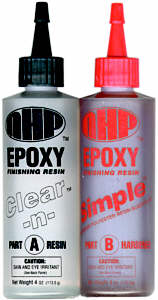NHP Clear-n-Simple Epoxy Finishing Resin
NHP - Clear-n-Simple Epoxy Finishing Resin {Supplies}
Contributed by Ric Testagrossa
| Overall Rating: | starstar_borderstar_borderstar_borderstar_border |
| Published: | 2010-03-04 |
| Manufacturer: | NHP |
 Brief:
Brief:
Since I've gotten many great tips for rocket construction from this site, I thought I'd give something back. I wanted to review a finishing epoxy to suggest to other rocketeers for reinforcing body tubes with fiberglass, instead I have some negative comments on this stuff and would suggest everyone stay away from it. The product is NHP "Clear-n-Simple Epoxy Finishing Resin".
First, a disclaimer about my experiences with fiberglassing: I'm not by any means an expert. When I was into R/C sailplanes, I used to fiberglass the wings. They came out light and strong but any expert looking at them closely would see that it was a "homemade" job. After being into rockets for several years, I started getting into larger, more powerful rockets and having fiberglass reinforced body tubes became necessary. I have fiberglassed all of my 4" rockets and some of my 2" and 3" rockets that were designed for high altitudes. I've used regular 30 minute epoxy on the smaller ones with OK results. I've used 2 hour epoxy on the larger ones with better results and used another brand of finishing epoxy on several 4" rockets and several 8" body tubes (which will become rockets shortly) with probably the best results yet.
Construction:
When I saw this product listed on a website I was purchasing some other rocket supplies from, it seemed like an excellent choice. Let me quote some of the advertising copy:
"Use Clear-n-Simple for applying fiberglass cloth"
"thin consistency for easy application"
"working time: 20-30 minutes and sets in 3 hours (curing times listed were determined at room temp of 72 degrees F in a 4 ounce mass). At temps below 72 degrees the curing time is considerably longer."
I ordered several 8oz. packages and when they arrived, I setup for glassing a short section of 8" diameter body tube; put everything in my 68 degree workshop, set the BT on a horizontal stand, cut the cloth, put on my gloves, and mix up 4 ounces of the epoxy. As I'm stirring it up, it looks kind of thick, about the consistency of honey, but maybe it will thin out as I work it. Nope. It goes on thick, with all the difficulties that follow: not wetting out the cloth well, puddling in some places and still dry in others. Trying to spread it out just creates wrinkles and bunching of the cloth. I try scraping with an old credit card that I use for just such situations but that doesn't help and within about 10 minutes after mixing it up, it starts to get to the "gluey" stage.
"Oh *^%&$# ", I think, "I've still got about a third of the body tube to do". I grab some alcohol and try mixing it in the now jelly-like mixture, but I can see that this isn't going to work. So I throw that batch out and quickly mix up about an ounce of new mixture, but this time I mix in the alcohol right away--hoping to get it to a thinner consistency from the start. Again it pretty much stays at the consistency of honey but I'm able to do the rest of the BT with it before it starts getting to the jelly stage.
Finishing:
I tear off my gloves and check the temp of the workshop; still at 68 degrees. I re-read the instructions: equal parts of resin and hardener, just like I used. Maybe those bottles were from a bad batch?
So I get a 4" coupler that needs to be fiberglassed, open up the other package of Clean-n-Simple, mix up a 2 oz batch, and it's the same story: thick consistency and gets jelly-like within about 10 minutes..
Summary:
As far as I know there's no way to fix this stuff, like if I heat up the components to thin out the mixture, it sets up even faster.
So my recommendation is stay away from this product. If you've already bought some, just use it for small repairs where the short working time won't be a problem.
I'm going to write a letter to the company explaining my experiences and if I hear anything back I'll let you know.
Overall Rating: 1 out of 5
 |
 |
W.T.K. (November 7, 2004)
R.T. (March 9, 2006)
H.W.H. (March 16, 2006)
Sponsored Ads
 |
 |












A.H. (November 2, 2004)